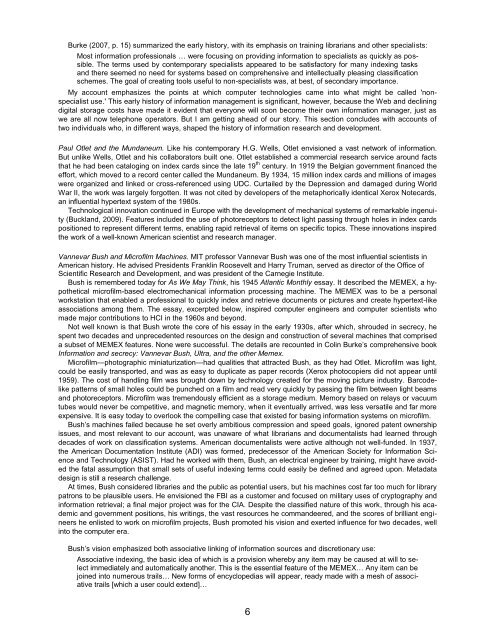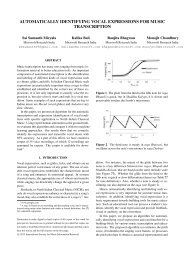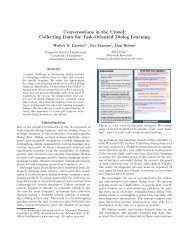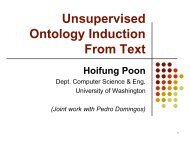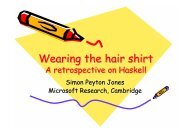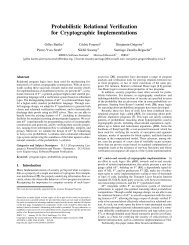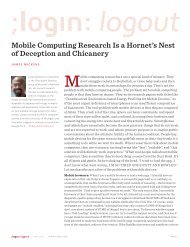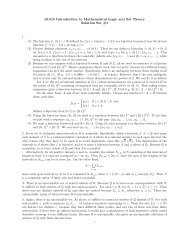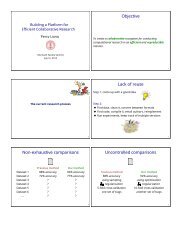A Moving Target—The Evolution of Human-Computer Interaction
A Moving Target—The Evolution of Human-Computer Interaction
A Moving Target—The Evolution of Human-Computer Interaction
Create successful ePaper yourself
Turn your PDF publications into a flip-book with our unique Google optimized e-Paper software.
Burke (2007, p. 15) summarized the early history, with its emphasis on training librarians and other specialists:<br />
Most information pr<strong>of</strong>essionals … were focusing on providing information to specialists as quickly as possible.<br />
The terms used by contemporary specialists appeared to be satisfactory for many indexing tasks<br />
and there seemed no need for systems based on comprehensive and intellectually pleasing classification<br />
schemes. The goal <strong>of</strong> creating tools useful to non-specialists was, at best, <strong>of</strong> secondary importance.<br />
My account emphasizes the points at which computer technologies came into what might be called 'nonspecialist<br />
use.' This early history <strong>of</strong> information management is significant, however, because the Web and declining<br />
digital storage costs have made it evident that everyone will soon become their own information manager, just as<br />
we are all now telephone operators. But I am getting ahead <strong>of</strong> our story. This section concludes with accounts <strong>of</strong><br />
two individuals who, in different ways, shaped the history <strong>of</strong> information research and development.<br />
Paul Otlet and the Mundaneum. Like his contemporary H.G. Wells, Otlet envisioned a vast network <strong>of</strong> information.<br />
But unlike Wells, Otlet and his collaborators built one. Otlet established a commercial research service around facts<br />
that he had been cataloging on index cards since the late 19 th century. In 1919 the Belgian government financed the<br />
effort, which moved to a record center called the Mundaneum. By 1934, 15 million index cards and millions <strong>of</strong> images<br />
were organized and linked or cross-referenced using UDC. Curtailed by the Depression and damaged during World<br />
War II, the work was largely forgotten. It was not cited by developers <strong>of</strong> the metaphorically identical Xerox Notecards,<br />
an influential hypertext system <strong>of</strong> the 1980s.<br />
Technological innovation continued in Europe with the development <strong>of</strong> mechanical systems <strong>of</strong> remarkable ingenuity<br />
(Buckland, 2009). Features included the use <strong>of</strong> photoreceptors to detect light passing through holes in index cards<br />
positioned to represent different terms, enabling rapid retrieval <strong>of</strong> items on specific topics. These innovations inspired<br />
the work <strong>of</strong> a well-known American scientist and research manager.<br />
Vannevar Bush and Micr<strong>of</strong>ilm Machines. MIT pr<strong>of</strong>essor Vannevar Bush was one <strong>of</strong> the most influential scientists in<br />
American history. He advised Presidents Franklin Roosevelt and Harry Truman, served as director <strong>of</strong> the Office <strong>of</strong><br />
Scientific Research and Development, and was president <strong>of</strong> the Carnegie Institute.<br />
Bush is remembered today for As We May Think, his 1945 Atlantic Monthly essay. It described the MEMEX, a hypothetical<br />
micr<strong>of</strong>ilm-based electromechanical information processing machine. The MEMEX was to be a personal<br />
workstation that enabled a pr<strong>of</strong>essional to quickly index and retrieve documents or pictures and create hypertext-like<br />
associations among them. The essay, excerpted below, inspired computer engineers and computer scientists who<br />
made major contributions to HCI in the 1960s and beyond.<br />
Not well known is that Bush wrote the core <strong>of</strong> his essay in the early 1930s, after which, shrouded in secrecy, he<br />
spent two decades and unprecedented resources on the design and construction <strong>of</strong> several machines that comprised<br />
a subset <strong>of</strong> MEMEX features. None were successful. The details are recounted in Colin Burke’s comprehensive book<br />
Information and secrecy: Vannevar Bush, Ultra, and the other Memex.<br />
Micr<strong>of</strong>ilm—photographic miniaturization—had qualities that attracted Bush, as they had Otlet. Micr<strong>of</strong>ilm was light,<br />
could be easily transported, and was as easy to duplicate as paper records (Xerox photocopiers did not appear until<br />
1959). The cost <strong>of</strong> handling film was brought down by technology created for the moving picture industry. Barcodelike<br />
patterns <strong>of</strong> small holes could be punched on a film and read very quickly by passing the film between light beams<br />
and photoreceptors. Micr<strong>of</strong>ilm was tremendously efficient as a storage medium. Memory based on relays or vacuum<br />
tubes would never be competitive, and magnetic memory, when it eventually arrived, was less versatile and far more<br />
expensive. It is easy today to overlook the compelling case that existed for basing information systems on micr<strong>of</strong>ilm.<br />
Bush’s machines failed because he set overly ambitious compression and speed goals, ignored patent ownership<br />
issues, and most relevant to our account, was unaware <strong>of</strong> what librarians and documentalists had learned through<br />
decades <strong>of</strong> work on classification systems. American documentalists were active although not well-funded. In 1937,<br />
the American Documentation Institute (ADI) was formed, predecessor <strong>of</strong> the American Society for Information Science<br />
and Technology (ASIST). Had he worked with them, Bush, an electrical engineer by training, might have avoided<br />
the fatal assumption that small sets <strong>of</strong> useful indexing terms could easily be defined and agreed upon. Metadata<br />
design is still a research challenge.<br />
At times, Bush considered libraries and the public as potential users, but his machines cost far too much for library<br />
patrons to be plausible users. He envisioned the FBI as a customer and focused on military uses <strong>of</strong> cryptography and<br />
information retrieval; a final major project was for the CIA. Despite the classified nature <strong>of</strong> this work, through his academic<br />
and government positions, his writings, the vast resources he commandeered, and the scores <strong>of</strong> brilliant engineers<br />
he enlisted to work on micr<strong>of</strong>ilm projects, Bush promoted his vision and exerted influence for two decades, well<br />
into the computer era.<br />
Bush’s vision emphasized both associative linking <strong>of</strong> information sources and discretionary use:<br />
Associative indexing, the basic idea <strong>of</strong> which is a provision whereby any item may be caused at will to select<br />
immediately and automatically another. This is the essential feature <strong>of</strong> the MEMEX… Any item can be<br />
joined into numerous trails… New forms <strong>of</strong> encyclopedias will appear, ready made with a mesh <strong>of</strong> associative<br />
trails [which a user could extend]…<br />
6


